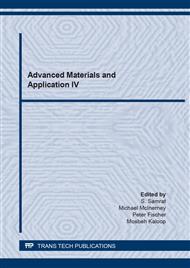[1]
S. Ji. W. Yang, F. Gao, D. Watoson, Z. Fan, Effect of Iron in Al-Mg-Si-Mn Ductile Diecast alloy, Light Metals (2013) 317-322.
DOI: 10.1002/9781118663189.ch55
Google Scholar
[2]
J. A. S. Green, Aluminum recycling and processing for energy conservation and sustainability, ASM international, (2007).
Google Scholar
[3]
W. Yang , S. Ji, X. Zhou, I. Stone, G. Scamans, G.E. Thomas, Z. Fan, hetero generous Nucleation of α-Al Grain on Primary α-AlFeMnSi Intermetallic Investigated Using 3D SEM Ultramicrotomy and HRTEM, Metallurgical Materials Transaction A45(2014) 3971-3930.
DOI: 10.1007/s11661-014-2346-6
Google Scholar
[4]
S. Ji, H. Yang, X. Cui, Z. Fan, Macro-heterogeneities in microstructures, concentrations, defects and tensile properties of die cast Al-Mg-Si alloys, Materials Science and Technology, 33(2017) 2223-2233.
DOI: 10.1080/02670836.2017.1334309
Google Scholar
[5]
X. Zhu, P. Blake, S. Ji, Strengthening Die-cast Al-Mg and Al-Mg-Mn alloys with Fe as a beneficial element, 732 (2018) 240-250.
DOI: 10.1016/j.msea.2018.07.005
Google Scholar
[6]
L.F. Gomes, B.L. Silvia, M. Garcia, J. Spinelli, Dendritic growth, solidification thermal parameters, Al-Mg-1.5 wt pct Fe alloys, Metal. & Mater. Trans. A 48A (2017) 1841-1855.
DOI: 10.1007/s11661-017-3978-0
Google Scholar
[7]
Y. Birol, S. AKDI, Cooling slope casting to produce NE AW 6082 forging stock for manufacture of suspension components, Trans. Nonferrous Met Soc. China 24 (2014) 1674-1682.
DOI: 10.1016/s1003-6326(14)63240-4
Google Scholar
[8]
S. I. Wang, M. K. Seo, J. R. Cho, W. B. Bae, A study on the development of large aluminum flange using the casting/forging process, J. Mater. Process. Technol. 130-131(2002) 294-298.
DOI: 10.1016/s0924-0136(02)00809-9
Google Scholar
[9]
Y. Briol, O. Ilgaz, S. Akdi, E. Unuvar, Comparison of cast and extruded stock for the forging of AA6082 alloy suspension parts, Advanced Material Research, 939(2014) 299-304.
DOI: 10.4028/www.scientific.net/amr.939.299
Google Scholar
[10]
K. Lee, Y. N. Kwon, S. Lee, Effects of eutectic silicon particles and fracture toughness of A356 aluminum alloys fabricated by low-pressure-casting, casting-forging, and squeeze-casting process, J. Alloys & Compound 461 (2008) 532-541.
DOI: 10.1016/j.jallcom.2007.07.038
Google Scholar
[11]
Y. L. Chang, F. Y. Hung, T. S. Lui, Study on microstructure and tensile properties of infrared-heat-treated cast-forged 6082 aluminum alloy, J. Mater. Res. Technol. 8 (2019) 173-179.
DOI: 10.1016/j.jmrt.2017.10.004
Google Scholar
[12]
H. Ono, S. Tomita, H. Ishii, A. Ogasawara, Forging shape in application of cast/forging process to Sl-Si-Mg alloy suspension parts, J. Japan Inst. Light Metals 45(1995) 187-192.
DOI: 10.2464/jilm.45.187
Google Scholar


